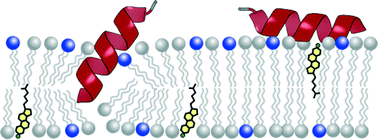Membranolytic anticancer peptides†
Abstract
Membranolytic anticancer peptides (ACPs) potentially offer new perspectives for the development of anticancer drugs. Their receptor-independent mechanisms of action hold the promise to hinder the development of resistance, which is a hurdle of many present-day chemotherapeutics. Peptide selectivity for cancer cells is believed to be primarily due to a net charge difference between neoplastic and non-neoplastic cells at the membrane surface. However, their exact molecular mechanisms are not yet fully understood. In this review, we summarise the state of the art of membranolytic ACP research and discuss the molecular features that have been related to the structure–activity relationships of alpha-helical ACPs.


 Please wait while we load your content...
Please wait while we load your content...